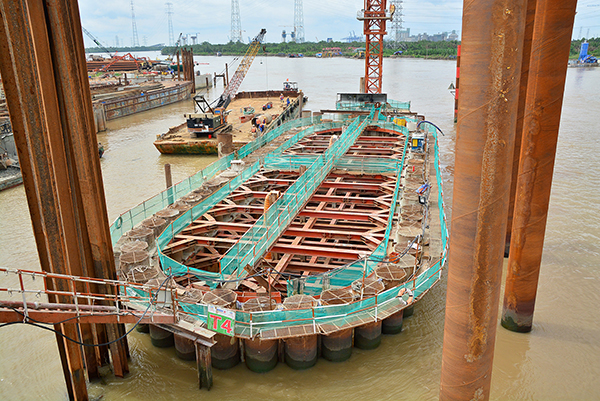Trung Nam Group clarifies information about the VND10-trillion antiflood project in HCMC
- HCM City’s new programme to reduce traffic congestion
- More than 10,000 people join Fund Run for Charity in HCM City
- Traffic jams choke major gateways in HCMC, Hanoi as holiday begins
Trung Nam Group on September 13 held a press-conference to provide information regarding a recent construction supervision consultant's allegation against the company.
 |
| Part of the project. |
The press-conference saw the participation of the Centre for Urban Flood Control of Ho Chi Minh City and five design, irrigation and construction consultancy units of the Ministry of Agricultural and Rural Development but no representative from Meinhardt Construction Consulting Limited Company, a member of the joint project consultancy, which had earlier accused Trung Nam Group of having replaced stainless steel with black steel to build floodgates of the project.
Fernando Requena, Chief Consultant - Managing Director of Meinhardt Construction Consulting Limited, in a dispatch sent to the Ho Chi Minh City Municipal People Committee, alleged that the use of black steel for the construction of Trieu Phu and Cay Kho sluice-gates (two of the six sluice-gates of the project) would increase the investment and maintenance costs of the project.
Speaking at the press conference, Trung Nam General Director Nguyen Tam Tien emphasized that there is no substitute for stainless steel into black steel. Tien also argued, the BT (build–transfer mode) contract, signed by the Ho Chi Minh City Municipal People's Committee and Trung Nam Group, does not include any terms, specifying the type of steel for the project. Thus, steel used for the construction of the floodgates can be optional, provided it meets the technical standards.
Regarding professional techniques, the construction drawings have the most important role in the project's construction and all construction activities must comply with the construction drawings. Meanwhile, drawings of the general design have only a reference role.
Tien said, before making the construction drawings, the designers had to survey, measure, calculate and experiment all aspects in detail to ensure technicality as well as to optimize the quality and efficiency of the project. The designers found out that the use of stainless steel with low intensity would increase the weight and size of floodgates while black steel has higher yield strength and less weight. As a result, the black steel is more appropriate to build Trieu Phu and Cay Kho floodgates.
Tien also emphasized that his company strictly comply with the working drawings while carrying out the project. The work has been checked by the construction supervision consultants and the Ministry of Agriculture and Rural Development for several times.
Although the adjusted design has been accepted by the investor, the cost of the construction will be inspected by the State Audit, so the company will certainly not benefit from the replacement of materials for the project. The black steel used for the Cay Kho and Phu Xuan floodgates cost twice as much as stainless steel but the volume of the used black steel was much lower, which has helped save up to VND90 billion, Tien said. He added that this type of steel still meets the requirements of construction quality and safety.
Earlier, Nguyen Hoang Anh Dung, deputy director of the city anti-flood center confirmed that, regarding BT projects, the Construction Law stipulates that the designer is not allowed to dictate what construction materials should be used for the project.
The group of construction supervision consultants seemed to have intentionally ignored this legal provision, and provided incorrect information for the city government, he noted.
Regarding the reasons for Trung Nam's decision to put the project on hold since April, Tien said the suspension of the project has resulted from the city authority’s delay in confirming the final workload of the project.
In the beginning of 2016, Ho Chi Minh City approved the first phase of a project run by Trung Nam Group to solve flooding in some places of the city due to tidewater and consequences of climate change with total investment of over VND 9.9 trillion. This is the largest-ever and most expensive anti-flooding construction project in HCM City.
The project focuses on building large underground culverts to push water into local rivers, and dyke systems in 1, 4, 7, 8, Nha Be and Binh Chanh districts. The project is scheduled to finish by the end of 2018. According to the Ho Chi City Minh Municipal People’s Committee, the anti- flooding project will contribute to reducing consequences of the flooding due to heavy rains and floodtide that affects an area of 570 square kilometers along Sai Gon River and in the center, home to 6.5 million residents. The project involves the districts of 1, 4, 7, 8 and Binh Tan, Nha Be and Binh Chanh.

